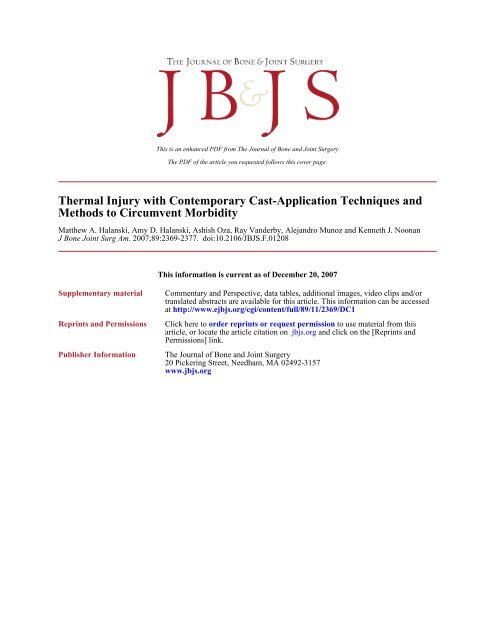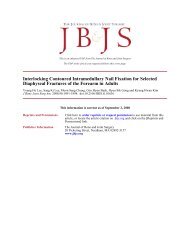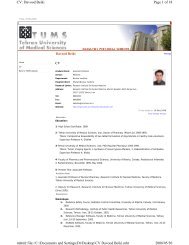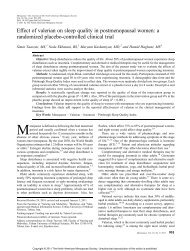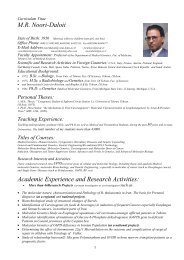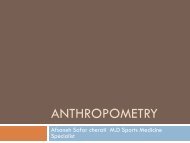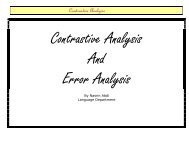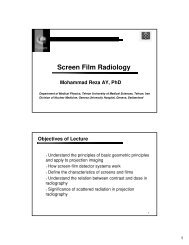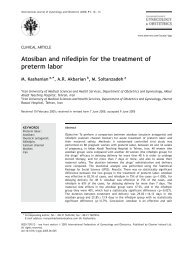Thermal Injury with Contemporary Cast-Application Techniques and ...
Thermal Injury with Contemporary Cast-Application Techniques and ...
Thermal Injury with Contemporary Cast-Application Techniques and ...
You also want an ePaper? Increase the reach of your titles
YUMPU automatically turns print PDFs into web optimized ePapers that Google loves.
This is an enhanced PDF from The Journal of Bone <strong>and</strong> Joint Surgery<br />
The PDF of the article you requested follows this cover page.<br />
<strong>Thermal</strong> <strong>Injury</strong> <strong>with</strong> <strong>Contemporary</strong> <strong>Cast</strong>-<strong>Application</strong> <strong>Techniques</strong> <strong>and</strong><br />
Methods to Circumvent Morbidity<br />
Matthew A. Halanski, Amy D. Halanski, Ashish Oza, Ray V<strong>and</strong>erby, Alej<strong>and</strong>ro Munoz <strong>and</strong> Kenneth J. Noonan<br />
J Bone Joint Surg Am. 2007;89:2369-2377. doi:10.2106/JBJS.F.01208<br />
Supplementary material<br />
Reprints <strong>and</strong> Permissions<br />
Publisher Information<br />
This information is current as of December 20, 2007<br />
Commentary <strong>and</strong> Perspective, data tables, additional images, video clips <strong>and</strong>/or<br />
translated abstracts are available for this article. This information can be accessed<br />
at http://www.ejbjs.org/cgi/content/full/89/11/2369/DC1<br />
Click here to order reprints or request permission to use material from this<br />
article, or locate the article citation on jbjs.org <strong>and</strong> click on the [Reprints <strong>and</strong><br />
Permissions] link.<br />
The Journal of Bone <strong>and</strong> Joint Surgery<br />
20 Pickering Street, Needham, MA 02492-3157<br />
www.jbjs.org
2369<br />
COPYRIGHT © 2007 BY THE JOURNAL OF BONE AND JOINT SURGERY, INCORPORATED<br />
<strong>Thermal</strong> <strong>Injury</strong> <strong>with</strong> <strong>Contemporary</strong><br />
<strong>Cast</strong>-<strong>Application</strong> <strong>Techniques</strong> <strong>and</strong><br />
Methods to Circumvent Morbidity<br />
By Matthew A. Halanski, MD, Amy D. Halanski, MD, Ashish Oza, BS,<br />
Ray V<strong>and</strong>erby, PhD, Alej<strong>and</strong>ro Munoz, PhD, <strong>and</strong> Kenneth J. Noonan, MD<br />
Investigation performed at the Department of Orthopaedics <strong>and</strong> Rehabilitation, University of Wisconsin, Madison, Wisconsin<br />
Background: <strong>Thermal</strong> injuries caused by application of casts continue to occur despite the development of newer<br />
cast materials. We studied the risk of these injuries <strong>with</strong> contemporary methods of immobilization.<br />
Methods: Using cylindrical <strong>and</strong> L-shaped limb models, we recorded the internal <strong>and</strong> external temperature changes<br />
that occurred during cast application. Variables that we assessed included the thickness of the cast or splint, dipwater<br />
temperature, limb diameter <strong>and</strong> shape, cast type (plaster, fiberglass, or composite), padding type, <strong>and</strong> placement<br />
of the curing cast on a pillow. These data were then plotted on known time-versus-temperature graphs to<br />
assess the potential for thermal injury.<br />
Results: The external temperature of the plaster casts was an average (<strong>and</strong> st<strong>and</strong>ard deviation) of 2.7° ± 1.9°C<br />
cooler than the internal temperature. The external temperature of twenty-four-ply casts peaked at an average of 84 ±<br />
42 seconds prior to the peak in the internal temperature. The average difference between the internal <strong>and</strong> external<br />
temperatures of the thicker (twenty-four-ply) casts (4.9° ± 1.3°C) was significantly larger than that of the thinner (six<br />
<strong>and</strong> twelve-ply) casts (1.5° ± 1°C) (p < 0.05). Use of dip water <strong>with</strong> a temperature of 24°C should be avoided. Splints should be<br />
cut to a proper length <strong>and</strong> not folded over. Placing the limb on a pillow during the curing process puts the limb at risk.<br />
Overwrapping of plaster in fiberglass should be delayed until the plaster is fully cured <strong>and</strong> cooled.<br />
Within the last two decades, advances in operative<br />
fixation for reconstruction or for treatment of a<br />
traumatic injury have greatly improved <strong>and</strong> thus<br />
diminished the need for cast immobilization. Despite these<br />
trends, casts are still commonly used in orthopaedics, <strong>and</strong> today<br />
residents receive less formal training in the art of cast immobilization.<br />
Potential complications associated <strong>with</strong> limb<br />
immobilization <strong>with</strong> plaster or synthetic casting tape are often<br />
overlooked. The prevalence of pressure ulcers, cast sores, <strong>and</strong><br />
thermal injuries is not frequently reported in the literature 1 ,<br />
yet cast-related problems such as burns are familiar to most<br />
orthopaedic surgeons.<br />
Plaster of Paris impregnated in fiber mesh has the following<br />
exothermic reaction to water: [Ca(SO 4 )]2⋅H 2 O (plas-<br />
Disclosure: In support of their research for or preparation of this work, one or more of the authors received, in any one year, a Departmental Grant<br />
of less than $10,000 from the Department of Orthopaedics <strong>and</strong> Rehabilitation, University of Wisconsin. Neither they nor a member of their immediate<br />
families received payments or other benefits or a commitment or agreement to provide such benefits from a commercial entity. No commercial<br />
entity paid or directed, or agreed to pay or direct, any benefits to any research fund, foundation, division, center, clinical practice, or other charitable<br />
or nonprofit organization <strong>with</strong> which the authors, or a member of their immediate families, are affiliated or associated.<br />
J Bone Joint Surg Am. 2007;89:2369-77 • doi:10.2106/JBJS.F.01208
THE JOURNAL OF BONE & JOINT SURGERY · JBJS.ORG<br />
VOLUME 89-A · NUMBER 11 · NOVEMBER 2007<br />
ter of Paris) + 3H 2 O → 2 (CaSO 4 ⋅2H 2 O) (gypsum) + heat.<br />
Previous studies have shown that the temperature generated<br />
by this reaction can cause tissue damage 2-4 . The amount of<br />
heat that is generated can be increased by many variables, including<br />
higher ambient temperature, the temperature of the<br />
reactants, <strong>and</strong> the concentration of reactants. These variables<br />
increase the rate of the reaction, thus producing more heat.<br />
Previously studied factors that increase heat production include<br />
increased layers of material (more than eight-ply), previously<br />
used dip water, <strong>and</strong> increased dip-water temperature 2-4 .<br />
Different commercial br<strong>and</strong>s of plaster produce different<br />
amounts of heat, probably as a result of their individual reaction<br />
rates or plaster concentrations. Fiberglass tape is another<br />
material that is commonly used, <strong>and</strong> it has several benefits in<br />
comparison <strong>with</strong> plaster, such as being lightweight, radiolucent,<br />
<strong>and</strong> waterproof <strong>and</strong> having lower peak temperatures<br />
during curing. The peak temperature during curing rarely<br />
exceeds 45°C; thus, the risk of thermal injury from synthetic<br />
fiberglass tape is substantially less than that associated <strong>with</strong><br />
the use of plaster 5 .<br />
Previous studies have confirmed the effects of thermal<br />
energy <strong>with</strong> regard to causing injury 6-9 . Cell damage may occur<br />
at temperatures of >50°C 6-8,10 . At the cellular level, this correlates<br />
<strong>with</strong> distorted cellular protein structure, altered metabolism,<br />
<strong>and</strong> changes in cell membrane permeability 6-11 . We<br />
hypothesized that different cast <strong>and</strong> limb variables could lead<br />
to temperatures high enough to cause this type of thermal injury.<br />
In the present study, we utilized an experimental model<br />
to discover which variables cause temperatures above this safe<br />
threshold <strong>and</strong> what, if anything, could be done to prevent<br />
these thermal injuries.<br />
Materials <strong>and</strong> Methods<br />
Experimental Model<br />
cylindrical limb (forearm) <strong>and</strong> an L-shaped limb (leg <strong>and</strong><br />
A<br />
foot) were constructed <strong>with</strong> polyvinylchloride pipe.<br />
Three diameters of the cylindrical limb— st<strong>and</strong>ard (48 mm),<br />
small (27 mm), <strong>and</strong> large (89 mm)—were tested. The Lshaped<br />
limb was constructed <strong>with</strong> 48-mm-diameter polyvinylchloride<br />
pipe. The exterior of each limb model was layered<br />
<strong>with</strong> a polyurethane-coated carbon fiber heating element<br />
(Thermion; Thermion Systems International, Stratford, Connecticut)<br />
consisting of a fine mesh of conductive carbon fibers<br />
that, when supplied <strong>with</strong> power, produce a uniform heat distribution;<br />
a constant temperature of 33°C to 35°C (human<br />
skin temperature) was maintained.<br />
Type-T wire thermocouples, adhesive <strong>and</strong> insulated types<br />
(Physitemp Instruments, Clifton, New Jersey, <strong>and</strong> Omega<br />
Engineering, Stamford, Connecticut), were then used to<br />
monitor temperatures at selected points on the artificial limb<br />
models (under the casts) <strong>and</strong> on the exterior of the casts. The<br />
manufacturer (Omega Engineering) reports the maximum<br />
range of st<strong>and</strong>ard limit of error on type-T thermocouples to<br />
be 0.75% or 1°C, whichever is greater. A four-channel thermocouple<br />
data-logger (MadgeTech, Warner, New Hampshire),<br />
which has a high accuracy (± 0.5°C) <strong>and</strong> resolution (0.1°C),<br />
2370<br />
T HERMAL INJURY WITH CONTEMPORARY CAST-APPLICATION<br />
TECHNIQUES AND METHODS TO CIRCUMVENT MORBIDITY<br />
was chosen for this study. Data points were acquired every ten<br />
seconds. Thermochromic liquid crystal thermometers (Telatemp,<br />
Fullerton, California, <strong>and</strong> Thermographic Measurements,<br />
Flintshire, United Kingdom) <strong>with</strong> a temperature range<br />
of 30°C to 60°C were also placed on the external surface of the<br />
cast at various points. On selected runs, readings from the external<br />
liquid crystal thermometer were obtained at roughly<br />
sixty-second intervals.<br />
Model Validation<br />
Our experimental limb model was tested against upper-limb<br />
casts worn by one of us (A.D.H.). This cast was applied in extension,<br />
centered on the elbow, <strong>and</strong> extended 6 in (15.2 cm)<br />
proximally <strong>and</strong> distally, <strong>and</strong> its dimensions (circumference,<br />
~24 cm; diameter, 76.4 mm) were between those of the st<strong>and</strong>ard<br />
<strong>and</strong> large upper-limb models. Adhesive T-type thermocouples<br />
(Omega Engineering) were applied to the skin <strong>and</strong> to<br />
the exterior of the casts <strong>with</strong> the same data-logging system. On<br />
the basis of our in vitro data, two separate attempts were made<br />
to apply a cast of twelve-ply thickness <strong>with</strong> use of 50°C dip<br />
water <strong>and</strong> cotton padding, but as a result of increasing temperature<br />
<strong>and</strong> discomfort these runs were aborted prematurely.<br />
Triplicate runs were then conducted <strong>with</strong> twelve-ply casts<br />
applied <strong>with</strong> use of lower dip-water temperatures of 37°C <strong>and</strong><br />
22°C to 24°C. The average ambient temperature (<strong>and</strong> st<strong>and</strong>ard<br />
deviation) during the reported human-limb runs was<br />
24.3°C ± 0.7°C. Internal temperatures were measured in the<br />
middle of the casts at the medial epicondyle <strong>and</strong> the anterior<br />
antecubital fossa. External temperatures were measured over<br />
this area <strong>with</strong> a thermocouple probe <strong>and</strong> an adhesive liquid<br />
crystal thermometer (Telatemp).<br />
Experimental Design<br />
Several variables were tested in this study, including limb diameter,<br />
limb shape (cylindrical <strong>and</strong> L-shaped), plaster thickness,<br />
cast type (plaster, fiberglass <strong>with</strong> a waterproof liner, <strong>and</strong><br />
composite [plaster overwrapped <strong>with</strong> fiberglass]), dip-water<br />
temperature, <strong>and</strong> placement of the cast on a pillow during<br />
curing. We evaluated different methods to avoid thermal injury,<br />
including the application of ice <strong>and</strong> isopropyl alcohol to<br />
curing casts. In addition, we attempted to determine whether<br />
the risk of thermal injury in the concavity of an L-shaped cast<br />
was decreased by placement of a circumferential overwrapping<br />
splint on the convexity of the limb, thus decreasing the<br />
thickness of the cast material in the concavity. Each variable<br />
was tested a minimum of three times <strong>with</strong> use of fresh dip water<br />
for each trial; the average ambient temperature for each<br />
trial was 22.4°C ± 2.1°C.<br />
Plaster casts were applied over three or four layers of<br />
cotton padding, <strong>and</strong> we tested cast thicknesses of six, twelve,<br />
<strong>and</strong> twenty-four-ply. Four-inch (10.2-cm) plaster b<strong>and</strong>ages<br />
(Specialist Extra Fast Setting Plaster; BSN Medical, Charlotte,<br />
North Carolina) were used in each plaster-cast experiment,<br />
<strong>and</strong> dip-water temperatures of 22°C to 24°C <strong>and</strong><br />
50°C were tested. The effects of limb diameter were assessed<br />
by testing the large (89-mm-diameter), st<strong>and</strong>ard (48-mm-
THE JOURNAL OF BONE & JOINT SURGERY · JBJS.ORG<br />
VOLUME 89-A · NUMBER 11 · NOVEMBER 2007<br />
diameter), <strong>and</strong> small (27-mm-diameter) limbs <strong>with</strong> a twelveply<br />
plaster cast applied <strong>with</strong> 50°C dip water. The internal<br />
<strong>and</strong> external cast temperatures were measured at the convexity<br />
<strong>and</strong> concavity of twelve-ply plaster casts applied <strong>with</strong><br />
50°C dip water to the L-shaped limbs. Similar methods were<br />
used for the splint studies, which involved use of twelve layers<br />
of the same plaster <strong>and</strong> cotton padding <strong>and</strong> overwrapping<br />
the splint <strong>with</strong> cotton <strong>and</strong> an elastic wrap. In these<br />
studies, the splint was purposely made too long so that one<br />
end could be folded back on itself. In the splint experiments,<br />
the dip water was maintained at 37°C. Four runs were conducted<br />
for the splint experiments because of data-collection<br />
problems during one run.<br />
The effects of placing a plaster cast on a pillow were assessed<br />
by removing the limb from the st<strong>and</strong> after application<br />
of the cast (twelve-ply plaster, 50°C dip water) <strong>and</strong> placing it<br />
on a st<strong>and</strong>ard hospital pillow (a polyester <strong>and</strong> vinyl shell <strong>with</strong><br />
polyester fill) covered in a pillow case (50%/50% cotton/polyester<br />
blend). Internal <strong>and</strong> external cast temperatures were<br />
monitored on the side facing the pillow, <strong>and</strong> the internal cast<br />
temperature was measured on the side facing the ambient air<br />
(top).<br />
The risk of thermal injury <strong>with</strong> use of synthetic casting<br />
tape (Scotchcast Plus; 3M Health Care, St. Paul, Minnesota)<br />
<strong>and</strong> either a normal cotton or a Gore-Tex liner (W.L.<br />
Gore, Flagstaff, Arizona) was assessed. These casts were applied<br />
<strong>with</strong> use of six-ply casting tape dipped in 50°C water.<br />
The effects of a composite cast were tested by immediately<br />
overwrapping a twelve-ply plaster cast <strong>with</strong> three-ply fiberglass,<br />
<strong>with</strong> both dipped in 50°C water.<br />
Intervention testing was performed only on plaster casts<br />
(twelve-ply, dipped in 50°C water). These tests included placement<br />
of st<strong>and</strong>ard reusable ice packs filled <strong>with</strong> ice between the<br />
pillow <strong>and</strong> the cast’s surface. We also tested the effect of fully<br />
saturating the cast <strong>with</strong> isopropyl alcohol when the internal<br />
temperature reached a level between 43°C <strong>and</strong> 46°C. Additionally,<br />
we tested whether the temperature rises in the concavity<br />
of an L-shaped limb would be ameliorated by applying<br />
a convex splint of six-ply plaster to the convexity prior to circumferential<br />
wrapping <strong>with</strong> six-ply plaster.<br />
Data Analysis<br />
From selected variables, peak temperatures <strong>and</strong> times were determined<br />
from the temperature graphs <strong>and</strong> were compared<br />
among the internal thermocouple, the external thermocouple,<br />
<strong>and</strong> the liquid crystal thermometer (when used). We also<br />
compared lag time <strong>and</strong> differences in peak temperature.<br />
Several authors have developed methods for evaluating<br />
potential thermal injury as a result of thermal conductance.<br />
In their classic studies, Henriques <strong>and</strong> Moritz described<br />
time-temperature relationships based on porcine <strong>and</strong> human<br />
experimental data <strong>and</strong> mathematical calculations 8,10 . More<br />
recently, Suzuki et al. found similar results in experiments on<br />
rats 9 . Williamson <strong>and</strong> Scholtz studied human subjects to determine<br />
blister formation as a relationship of time <strong>and</strong><br />
temperature 12 , <strong>and</strong> Lavalette et al. 2 used the results of William-<br />
2371<br />
T HERMAL INJURY WITH CONTEMPORARY CAST-APPLICATION<br />
TECHNIQUES AND METHODS TO CIRCUMVENT MORBIDITY<br />
son <strong>and</strong> Scholtz to generate a mathematical basis for blister<br />
formation in order to study the thermal effects of cast application.<br />
We used the classic work of Henriques <strong>and</strong> Moritz as well<br />
as that of Lavalette et al. to qualitatively analyze the risk of<br />
thermal injury. Each set of authors provided an equation or<br />
data for a reference line, which was plotted on a log timeversus-temperature<br />
graph to represent the threshold at which<br />
thermal injury can be predicted to occur. Henriques <strong>and</strong><br />
Moritz equated this injury <strong>with</strong> transepidermal necrosis, <strong>and</strong><br />
Lavalette et al. equated it <strong>with</strong> the degree of burn. If the experimental<br />
data clearly crossed the reference lines, the limb was<br />
considered to be at risk for injury. We initially plotted our experimental<br />
data on the graphs of Lavalette et al. <strong>and</strong> subsequently<br />
also evaluated many of these variables on graphs<br />
based on the equations <strong>and</strong> data of Henriques 10 . For clarity,<br />
only the reference lines presented by Henriques <strong>and</strong> Moritz<br />
are shown in this article. (Graphic representation of the other<br />
methods of burn evaluation can be found in the Appendix.)<br />
Statistical differences in the risk of burns between variables<br />
were then determined <strong>with</strong> use of the Fisher exact text. The<br />
significance of differences in peak temperatures was determined<br />
<strong>with</strong> use of the Student t test. P values of
THE JOURNAL OF BONE & JOINT SURGERY · JBJS.ORG<br />
VOLUME 89-A · NUMBER 11 · NOVEMBER 2007<br />
Fig. 1<br />
Fig. 2<br />
With regard to the plaster casts, we found that maintaining<br />
the dip-water temperature at
THE JOURNAL OF BONE & JOINT SURGERY · JBJS.ORG<br />
VOLUME 89-A · NUMBER 11 · NOVEMBER 2007<br />
Fig. 3<br />
2373<br />
T HERMAL INJURY WITH CONTEMPORARY CAST-APPLICATION<br />
TECHNIQUES AND METHODS TO CIRCUMVENT MORBIDITY<br />
Representative plot for casts made of various materials applied <strong>with</strong> a 50°C dip-water tempera-<br />
ture. Use of synthetic material did not produce dangerous temperatures regardless of the lining<br />
material. <strong>Cast</strong>s constructed of twelve-ply plaster did not produce dangerously high temperatures<br />
unless they were immediately overwrapped <strong>with</strong> fiberglass tape.<br />
Fig. 4<br />
Representative plot for a curing cast placed on top of a st<strong>and</strong>ard-issue hospital pillow. Danger-<br />
ously high internal temperatures can be produced on the bottom surface of the limb when a cur-<br />
ing cast (twelve-ply plaster dipped in 50°C water) is placed on a pillow. *Note that the exposed<br />
top peak temperatures remain significantly cooler.
THE JOURNAL OF BONE & JOINT SURGERY · JBJS.ORG<br />
VOLUME 89-A · NUMBER 11 · NOVEMBER 2007<br />
four-ply consistently yielded temperatures that were high<br />
enough to cause burns (p < 0.05) (see Appendix). Similarly, if<br />
a twelve-ply plaster splint was applied <strong>and</strong> the end was folded<br />
over, creating a twenty-four-ply area, the risk of thermal injury<br />
in that area was significant (p < 0.05) (Fig. 2). While the<br />
average peak temperature was slightly higher for the small<br />
limbs (50.9°C ± 1°C) <strong>and</strong> lower for the st<strong>and</strong>ard (50.5°C ±<br />
1°C) <strong>and</strong> large (49.9°C ± 1.7°C) limbs, these differences were<br />
not significant. <strong>Application</strong> of a cast to an L-shaped limb consistently<br />
produced higher temperatures in the concavity (average,<br />
60.1°C) <strong>and</strong> lower temperatures on the convexity (52.1°C).<br />
The peak temperature could be decreased significantly (p <<br />
0.05) by reinforcing the convexity <strong>with</strong> a slab of plaster <strong>and</strong> reducing<br />
the number of circumferential wraps by 50% (six-ply)<br />
on the concavity.<br />
Overwrapping a curing plaster cast <strong>with</strong> fiberglass caused<br />
temperatures high enough to cause thermal injury (p < 0.05,<br />
compared <strong>with</strong> the temperatures of plaster <strong>and</strong> fiberglass alone)<br />
(Fig. 3). Similarly, placement of a limb <strong>with</strong> a twelve-ply cast<br />
on a pillow yielded temperatures on the interior surface that<br />
were high enough to cause thermal damage. In these runs, the<br />
peak temperatures on the top, uncovered part of the limb<br />
were significantly lower than those on the bottom (p < 0.05)<br />
(Fig. 4). This increase in temperature was averted by simply<br />
placing ice packs between the pillow <strong>and</strong> the cast (Fig. 5). <strong>Application</strong><br />
of isopropyl alcohol to the exterior of the casts that<br />
were prone to lead to thermal injury did not significantly de-<br />
Fig. 5<br />
2374<br />
T HERMAL INJURY WITH CONTEMPORARY CAST-APPLICATION<br />
TECHNIQUES AND METHODS TO CIRCUMVENT MORBIDITY<br />
crease the interior peak temperature or decrease the risk of<br />
injury (Fig. 6).<br />
Discussion<br />
umans feel the painful stimuli of conducted thermal<br />
H<br />
energy when temperatures are applied in the range of<br />
47°C to 49°C 8,13 . On the basis of the results of experimental<br />
<strong>and</strong> theoretical modeling, it is thought that living tissues<br />
can accommodate some changes in temperature <strong>with</strong>out<br />
damage 7-10,12 . Once the thermal energy exceeds a critical<br />
level, the tissue can no longer accommodate increases <strong>with</strong>out<br />
damage 6-10,12 . Henriques <strong>and</strong> Moritz defined this relationship<br />
more than fifty years ago, <strong>and</strong> their work is still<br />
being used to model thermal injury 8,10 . Near the time of its inception,<br />
the time-temperature relationship was believed to<br />
reflect the thermal alteration in proteins, alteration in enzymatic<br />
<strong>and</strong> nonenzymatic metabolic processes, <strong>and</strong> nonprotein-induced<br />
alterations in the physical properties of<br />
cells. Henriques suggested that his findings were similar to<br />
observations based on protein denaturation 10 . Since then,<br />
Xu <strong>and</strong> Qian proposed that Henriques’ data could be modeled<br />
by attributing the damage to the deactivation of cellular<br />
enzymes 11 . More recently, Despa et al. used computer<br />
modeling to determine which cellular macromolecules are<br />
most thermally sensitive 6 . They found the lipid membrane<br />
to be the most thermally sensitive <strong>and</strong> believed DNA to be<br />
particularly thermally stable. The ability to model <strong>and</strong> pre-<br />
Representative plot for a curing cast (twelve-ply plaster dipped in 50°C water) <strong>with</strong> st<strong>and</strong>ard hos-<br />
pital ice packs placed between the cast <strong>and</strong> the pillow. This intervention decreases the insulator<br />
effect of the pillow seen in Figure 4.
THE JOURNAL OF BONE & JOINT SURGERY · JBJS.ORG<br />
VOLUME 89-A · NUMBER 11 · NOVEMBER 2007<br />
Fig. 6<br />
dict thermal injury has been used to help prevent such<br />
injury 14,15 .<br />
While thermal injuries from the application of plaster<br />
casts are more likely to be encountered than reported in the<br />
literature, there have been reports of clinical <strong>and</strong> experimental<br />
findings 1,4,16 . Previous investigators have evaluated risk factors<br />
associated <strong>with</strong> thermal injury, such as the br<strong>and</strong> of cast<br />
material, cast thickness, dip-water temperature, <strong>and</strong> placement<br />
of the limb on a pillow during the curing process. These<br />
studies focused only on the use of circumferential casts on<br />
similarly sized straight limbs, <strong>and</strong> the experimental limb used<br />
in some of these studies was essentially a water-filled glass<br />
cylinder. While this model can adequately maintain temperature<br />
<strong>and</strong> provide enough stability to allow application of a<br />
cast, it was not possible to test variables such as size <strong>and</strong><br />
shape as we did in the present study. Recent technology also<br />
allowed easy real-time measurements to be made every ten seconds,<br />
thereby generating temperature curves that are better<br />
than those obtained in previous studies. In addition, we compared<br />
several different methods for predicting burns (see<br />
Appendix) <strong>and</strong> evaluated much of our data <strong>with</strong> two of<br />
them (those of Henriques 10 <strong>and</strong> Lavalette et al. 2 ). Both methods<br />
led to identical results <strong>and</strong> conclusions for almost every<br />
variable tested.<br />
In this study, the temperatures, temperature differentials<br />
(skin surface compared <strong>with</strong> the exterior of the cast), <strong>and</strong><br />
curve patterns for the human limb were similar to those for<br />
the experimental limb. Small differences in limb size, cotton<br />
thickness, <strong>and</strong> ambient temperatures were noted, but the similarity<br />
between the experimental <strong>and</strong> human limbs demon-<br />
2375<br />
T HERMAL INJURY WITH CONTEMPORARY CAST-APPLICATION<br />
TECHNIQUES AND METHODS TO CIRCUMVENT MORBIDITY<br />
Representative plot for casts treated <strong>with</strong> alcohol <strong>and</strong> those for which alcohol was not used. Ap-<br />
plication of alcohol tended to decrease internal temperature only by 3° to 4°C, which would not<br />
be expected to obviate thermal injury in a thick (twenty-four-ply) plaster cast that was made <strong>with</strong><br />
a high dip-water temperature (50°C).<br />
strates the usefulness of this model. Goto <strong>and</strong> Ogata measured<br />
the temperatures generated while applying splints to models<br />
<strong>and</strong> human limbs 4 <strong>and</strong> found the mean peak temperatures in<br />
their model (54°C) to be significantly higher than those of the<br />
human limb (46°C). They, however, used only plaster splints<br />
<strong>and</strong> did not clearly describe their model, which was probably<br />
different from the one presented in our study. They also did<br />
not describe the method of statistical evaluation of their data;<br />
thus, it is difficult to make comparisons <strong>with</strong> the present<br />
study. It should be noted, however, that, despite the lower<br />
temperatures in the human subjects, several were found to<br />
have first-degree burns following the experiments.<br />
Obviously, one could not ethically test the extreme variables<br />
presented in our report on a human subject as they<br />
could lead to injury. We attempted to use our higher dipwater<br />
temperature (50°C) to apply a mid-range-thickness<br />
(twelve-ply) cast to the arm of an investigator, but the test<br />
had to be aborted before completion (i.e., when the internal<br />
temperature reached 43°C to 47°C) because it became too<br />
painful. This experience correlated <strong>with</strong> the findings in our<br />
model, which predicted that those variables would generate<br />
temperatures on the verge of causing a first-degree burn. In<br />
addition, the values derived from the experimental model <strong>and</strong><br />
the human limb were similar when we compared the internal<br />
<strong>and</strong> exterior temperatures of the thinner casts applied <strong>with</strong><br />
lower dip-water temperatures. On the basis of the validation<br />
testing, we believe that our experimental model simulates<br />
changes in skin surface temperature when a cast is applied.<br />
Williamson <strong>and</strong> Scholtz described individual differences between<br />
some of the subjects in their study, but noticed that
THE JOURNAL OF BONE & JOINT SURGERY · JBJS.ORG<br />
VOLUME 89-A · NUMBER 11 · NOVEMBER 2007<br />
general trends occurred 12 . There may be some individual<br />
differences between subjects as a result of differences in age,<br />
body fat percentage, amount of muscle, osseous prominences,<br />
<strong>and</strong> vascularity. However, we believe that elucidating these<br />
differences in response to heat, high enough to cause damage,<br />
is not possible in human subjects for ethical reasons.<br />
Limitations of this study should be pointed out. We may<br />
have underestimated the true thermal damage caused by each<br />
of the variables. The plots developed by Henriques 10 <strong>and</strong> Williamson<br />
<strong>and</strong> Scholtz 12 <strong>and</strong> adopted by Lavalette et al. 2 are based<br />
on a constant temperature maintained for a period of time. In<br />
our study as well as that by Lavalette et al., the temperature of<br />
the cast material followed a bell-shaped curve. One can only<br />
plot the data obtained during cast application on the curves<br />
presented by Henriques <strong>and</strong> Lavalette et al. if time zero is assumed<br />
to be the time of the peak temperature. This essentially<br />
ignores the thermal energy <strong>and</strong> its potential to cause injury as<br />
the cast is “heating up.” The curve during this process is rather<br />
steep <strong>and</strong> the overall thermal effects were thought to be minor,<br />
but they could have added to the overall effects that were measured.<br />
In addition, the previous burn data are based on small<br />
areas of tissue exposed to varying temperatures. None of the<br />
authors of these studies measured the effects of exposing an<br />
entire limb segment to an increased temperature. Also, each of<br />
our conclusions regarding the risk of thermal damage was<br />
based solely on in vitro data plotted on graphs developed<br />
primarily from in vivo studies. The validity of this type of<br />
transfer is unknown, <strong>and</strong> the effects on actual patients may be<br />
different; however, as stated previously, we believe the trends<br />
<strong>and</strong> conclusions would be similar. Despite the above concerns,<br />
we concur <strong>with</strong> the conclusions of Pope et al. 5 that synthetic<br />
tape is relatively thermally safe throughout the range of dipwater<br />
temperatures tested. However, we updated these find-<br />
Fig. 7<br />
2376<br />
T HERMAL INJURY WITH CONTEMPORARY CAST-APPLICATION<br />
TECHNIQUES AND METHODS TO CIRCUMVENT MORBIDITY<br />
ings by showing that they hold true for the new waterproof<br />
cast padding.<br />
We have shown that the external temperature of a cast<br />
correlates well <strong>with</strong> the internal temperature at the skin surface.<br />
Lavalette et al. 2 noticed that the external temperature of<br />
the casts followed curves that were similar to, but lower than,<br />
the curves followed by the internal temperatures. However, in<br />
that study, no attempts were made to correlate the two temperatures<br />
<strong>and</strong> to use the external temperature to predict the<br />
internal temperature. In our study, we found a slight lag time<br />
between the peak internal <strong>and</strong> external temperatures <strong>and</strong><br />
slightly lower temperatures were measured externally. Although<br />
these differences appear to increase <strong>with</strong> the plaster<br />
thickness, even <strong>with</strong> the thickest plaster tested, which was most<br />
likely thicker than generally would be used clinically, these<br />
differences were less than ninety seconds <strong>and</strong> 7°C, respectively.<br />
Monitoring the external temperature may provide the<br />
clinician a way to estimate the temperature inside of a recently<br />
applied cast or splint.<br />
We hypothesized that a smaller limb would be more at<br />
risk for a burn than a larger limb; however, we could not demonstrate<br />
this. While the surface area of a limb or cylinder increases<br />
in a linear fashion <strong>with</strong> increasing limb diameter, the<br />
amount of plaster also increases. This is perhaps why we did<br />
not see a significant difference in thermal risk among limb<br />
sizes. On the other h<strong>and</strong>, we showed that, as a result of the<br />
increased amount of cast material that accumulates in the<br />
concavity of an L-shaped limb, the risk of thermal injury is increased<br />
in this area. Using a plaster slab for reinforcement over<br />
the convexity <strong>and</strong> limiting the number of circumferential<br />
wraps minimize the amount of plaster in the concavity <strong>and</strong><br />
therefore decrease the peak temperatures in this area.<br />
We believe that the splinting data in this study are im-<br />
Representative plot of the effect of alcohol application on internal <strong>and</strong> external cast tempera-<br />
tures. After application of alcohol, the external temperature quickly decreases; however, the in-<br />
ternal temperature continues to rise.
THE JOURNAL OF BONE & JOINT SURGERY · JBJS.ORG<br />
VOLUME 89-A · NUMBER 11 · NOVEMBER 2007<br />
portant as there is a risk of thermal injury when a fracture is<br />
splinted postoperatively. All too often, a splint is folded over<br />
when it has been cut to an inappropriate length, but this essentially<br />
doubles its thickness in a small area <strong>and</strong> thus increases<br />
the local exothermic reaction. Our recommendation<br />
is to trim excess plaster <strong>and</strong> resist the temptation to fold over<br />
the ends.<br />
We have offered potential interventions for reducing<br />
thermal risk, such as placing ice packs between the limb <strong>and</strong><br />
the pillow. Safer ways to avoid the risk of thermal injury in this<br />
setting would be to hold the limb or allow it to hang free during<br />
the curing process. The use of isopropyl alcohol to decrease<br />
the temperature of a curing cast has been reported<br />
anecdotally 17 . Our attempts to use it in this way revealed that,<br />
while the external temperature of the cast may go down, the<br />
internal temperature is minimally affected. In fact, the clinician<br />
may be fooled into thinking that the interior of the cast is<br />
cool because he or she can feel the external surface of the cast<br />
cooling (Fig. 7).<br />
In conclusion, the data on plaster material that were derived<br />
<strong>with</strong> the current model support previous authors’ findings,<br />
in particular that application of thicker plaster casts <strong>with</strong><br />
use of higher dip-water temperatures <strong>and</strong> placement of the<br />
limb on a pillow may lead to temperatures high enough to<br />
cause thermal injury. In addition, we were able to determine<br />
the temperature at various locations on the limb under the<br />
cast. This information is important so that clinicians realize<br />
that, while the temperature at one location of the cast may feel<br />
safe, the temperature elsewhere (i.e., in contact <strong>with</strong> the pil-<br />
1. Kaplan SS. Burns following application of plaster splint dressings. Report of<br />
two cases. J Bone Joint Surg Am. 1981;63:670-2.<br />
2. Lavalette R, Pope MH, Dickstein H. Setting temperatures of plaster casts.<br />
The influence of technical variables. J Bone Joint Surg Am. 1982;64:907-11.<br />
3. Gannaway JK, Hunter JR. <strong>Thermal</strong> effects of casting materials. Clin Orthop<br />
Relat Res. 1983;181:191-5.<br />
4. Goto M, Ogata K. Experimental study on thermal burns caused by plaster<br />
b<strong>and</strong>age. Nippon Seikeigeka Gakkai Zasshi. 1986;60:671-80.<br />
5. Pope MH, Callahan G, Lavalette R. Setting temperatures of synthetic casts.<br />
J Bone Joint Surg Am. 1985;67:262-4.<br />
6. Despa F, Orgill DP, Neuwalder J, Lee RC. The relative thermal stability of tissue<br />
macromolecules <strong>and</strong> cellular structure in burn injury. Burns. 2005;31:568-77.<br />
7. Henriques FC Jr, Moritz AR. Studies of thermal injury. I. The conduction of heat<br />
to <strong>and</strong> through skin <strong>and</strong> the temperatures attained therein. A theoretical <strong>and</strong> an<br />
experimental investigation. Am J Pathol. 1947;23:531-49.<br />
8. Moritz AR, Henriques FC Jr. Studies in thermal injury. II. The relative importance<br />
of time <strong>and</strong> surface temperature in the causation of cutaneous burns. Am J<br />
Pathol. 1947;23:695-720.<br />
9. Suzuki T, Hirayama T, Aihara K, Hirohata Y. Experimental studies of moderate<br />
2377<br />
References<br />
T HERMAL INJURY WITH CONTEMPORARY CAST-APPLICATION<br />
TECHNIQUES AND METHODS TO CIRCUMVENT MORBIDITY<br />
low) may not be. We also showed that overwrapping a curing<br />
plaster cast <strong>with</strong> fiberglass significantly increases its internal<br />
temperature. Allowing time for the plaster to cure completely<br />
before it is overwrapped <strong>with</strong> fiberglass should eliminate this<br />
problem.<br />
Appendix<br />
Three additional figures, including a plot of skin surface<br />
<strong>and</strong> external temperatures of a twelve-ply cast applied to<br />
the arm of an investigator, a comparison of skin (human) <strong>and</strong><br />
surface (model) temperatures after application of a twelve-ply<br />
cast (37°C), <strong>and</strong> a graph of representative plots of temperatures<br />
causing thermal injury (reference lines) are available <strong>with</strong> the<br />
electronic versions of this article, on our web site at jbjs.org<br />
(go to the article citation <strong>and</strong> click on “Supplementary Material”)<br />
<strong>and</strong> on our quarterly CD-ROM (call our subscription<br />
department, at 781-449-9780, to order the CD-ROM). <br />
NOTE: The authors thank the University of Wisconsin School of Biomedical Engineering students<br />
Stacey Hoebel, Kristin LaFortune, Katie Mantz, <strong>and</strong> Liz Thottakara for their help in the<br />
development <strong>and</strong> design of the experimental limbs used in this study.<br />
Matthew A. Halanski, MD<br />
Amy D. Halanski, MD<br />
Ashish Oza, BS<br />
Ray V<strong>and</strong>erby, PhD<br />
Alej<strong>and</strong>ro Munoz, PhD<br />
Kenneth J. Noonan, MD<br />
Department of Orthopaedics <strong>and</strong> Rehabilitation, University of Wisconsin,<br />
K4/732 Clinical Science Center, 600 Highl<strong>and</strong> Avenue, Madison, WI<br />
53792. E-mail address for K.J. Noonan: noonan@orthorehab.wisc.edu<br />
temperature burns. Burns. 1991;17:443-51.<br />
10. Henriques FC Jr. Studies of thermal injury. V. The predictability <strong>and</strong> the significance<br />
of thermally induced rate processes leading to irreversible epidermal injury.<br />
Arch Pathol. 1947;43:489-502.<br />
11. Xu Y, Qian R. Analysis of thermal injury process based on enzyme deactivation<br />
mechanisms. J Biomech Eng. 1995;117:462-5.<br />
12. Williamson C, Scholtz JR. Time-temperature relationships in thermal blister<br />
formation. J Invest Dermatol. 1949;12:41-7.<br />
13. LaMotte RH, Torebjörk HE, Robinson CJ, Thalhammer JG. Time-intensity profiles<br />
of cutaneous pain in normal <strong>and</strong> hyperalgesic skin: a comparison <strong>with</strong> C-fiber<br />
nociceptor activities in monkey <strong>and</strong> human. J Neurophysiol. 1984;51:1434-50.<br />
14. Subramanian B, Chato JC. Safe touch temperatures for hot plates. J Biomech<br />
Eng. 1998;120:727-36.<br />
15. Diller KR. Adapting adult scald safety st<strong>and</strong>ards to children. J Burn Care Res.<br />
2006;27:314-24.<br />
16. Becker DW. Danger of burns from fresh plaster splints surrounded by too<br />
much cotton. Plast Reconstr Surg. 1978;62:436-7.<br />
17. Wuest T. Use of alcohol to decrease temperature of a hot plaster. Personal<br />
communication, 1993.


